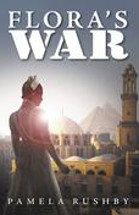Flora's war by Pamela Rushby

Ford Street Publishing, 2013 ISBN 9781921665981.
(Age: 11+) Flora's war begins in late 1914 in Cairo, where
the somewhat indulged daughter of an Australian archaeologist whose
only interest is discovering the antiquities of Ancient Egypt, meets
up with her American friend Gwen, quite determined to be 'modern
young ladies' of the time now that they are 16 and having 'come
out', are afforded much more freedom. Flora's war ends a
year later in Cairo where two much more mature young ladies
contemplate their future having seen and done much more than 'modern
young ladies' should have - in fact having seen and done much more
than modern young ladies (or gents) of any generation should have.
Cairo in 1914 is not the place Gwen and Flora have known from their
annual visits for the excavation season since childhood. Instead of
the close-knit expatriate society they know, the riches and richness
of the privileged life of hotels where steps are swept as soon as
they are stepped upon, and the endless desert stretching to the
beckoning pyramids, it is becoming more and more crowded with troops
from Britain, Australia and New Zealand and tent cities are
springing up. There is an air of expectation that something is going
to happen, strengthened by the military's acquisition of their
hotels for hospitals and the girls being commandeered to volunteer
as helpers in Lady Bellamy's rest and recreation centre - a pavilion
in the Ezbekieh Gardens where soldiers on leave will be tempted with
tea and table tennis to distract them from the salacious attractions
of 'The Wozzer'. The war is acknowledged but it is far away from
Egypt, yet still the troop build-up and training continues and the
arrival of contingents of Australian nurses is an ominous sign. But,
undeterred, Flora and Gwen push on to being modern young women,
learning to dance in new ways, smoking cigarettes, hosting
spectacular parties, and most importantly for their freedom,
learning to drive a car. And it is this skill which takes them to
sights, sounds, smells and experiences that no one should ever
endure, let alone 16 year-old girls. For, as what we now know as the
Gallipoli Campaign begins and intensifies, the war comes to Cairo as
tens of thousands of wounded soldiers are evacuated and Flora and
Gwen are enmeshed in their care.
There have been so many books written about the events of 1915 on
the Gallipoli Peninsula, events that have shaped the Australian and
New Zealand psyche and spawned the enduring ANZAC spirit of
collaboration and rivalry, and as the centenary approaches there
will be more. But Flora's war is different - it's written
from the perspective of 'what happened next'. We know the facts and
figures and stories of the soldiers in the trenches and the bravery,
courage and losses, but what happened to those who were injured,
those who were evacuated to the hospital ships sitting just
offshore? So often the stories stop on the beach. In the notes, the
author, Pamela Rushby tells of her journey from reading a story
about Australian nurses in 1915 to writing a story of a young
civilian volunteer in Egypt, and it is this aspect that makes this
novel stand out. Even though Flora Wentworth is fictional, it is
nevertheless the story of real people, inspirational people whose
story has seldom been told.
Flora's war is an engaging read, written by a hand that knows
how to weave light and dark together so that the reader is
entertained but also educated. Flora loves her social life and we
learn how the social conventions of the time remain paramount - as
unmarried young women, their duties are arranged so they cannot see
men without their pyjama tops, yet emptying bedpans is acceptable -
contrasted against the pathos of young men knowing they may never
return from this 'adventure' they signed on for. It paints a picture
of a time in history that we all know, that has been rarely seen.
Like Boy soldiers by Cliff Green, this is a story that
stands above others on this topic for me. My copy will stay on my
shelves until my granddaughters are old enough to read it and
perhaps understand what their great great grandfather endured.
There are Teachers'
notes written by the author and these offer a range of ideas
which take this story beyond the realm of a girls' own adventure to
a work that has a real place in supporting our students'
understanding of this critical piece of Australian history. If you
are looking to boost your collection in anticipation of the 1915
centenary of Anzac Day, this should be at the top of your list.
Barbara Braxton